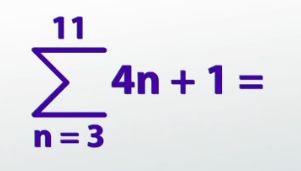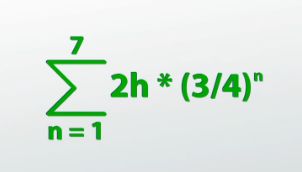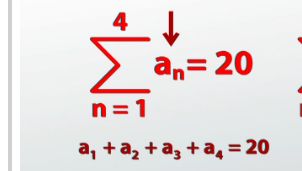Arithmetic and Geometric Series: Practice Problems
After you watch the video and know the material, click HERE for the quiz.
There are many different types of problems concerning series and sequences - including some that are pretty abstract. From bouncing balls to adding up odd numbers, test your skills here with additional arithmetic and geometric series practice!
Intro to Practice Problems
Now that you're familiar with both arithmetic and geometric series, it's time to test your skills with a few more examples. We'll need to remember the two shortcuts for finding arithmetic and geometric series. These two formulas are all we need for these examples. With that being said, these problems are a little more abstract than ones we've already done in previous lessons, so you're going to have to do some thinking before you can plug in numbers and be done.
Because of that, it may be a good idea to pause the video after I've finished each example (maybe rewind it to the beginning), write the problem down and try to do it yourself without me helping. This way, you'll quiz yourself to make sure you understand what each question is asking you before you go on to the next one.
Practice Problem #1
So, let's get take a look at our first example. I see a sigma, which tells me I'm taking a sum, and then the rule (directly to the right of that) looks like y = mx + b. So, I know it's an arithmetic sum, which means I'm going to be using this formula: sigma = (n/2)(a_1+a_n). But, there is once difference to this problem that we haven't looked at, and that is that the sum does not start at n = 1, it starts at n = 3.
 |
Second of all, the n in the n/2 part of this formula, represents the number of terms in the series. In this case, it's not as easy as substituting n_11. Since I'm starting at 3 and going up through 11, there aren't actually 11 different entries in this series. Because I'm starting at 3, I'm skipping over number 1 and 2. So, there are actually only 11 - 2 terms, which is 9 terms in this series.
A common mistake is to do 11 - 3 = 8 (so the top number minus the bottom number and that would give you 8), but that would be incorrect because it would imply that we are excluding 3 (because we'd be subtracting 3 away). We want to include 3, so we should do 11 - 2 = 9, because only the first and second entries are the ones excluded. That's how we get 9.
Now that we've substituted all the correct values, it's easy as evaluating the formula out. So, a_3 we find by substituting 3 for our formula 4n + 1. And, a_n is our last term, so in this case we'll substitute 11 into the formula and we end up with: (9/2) * ((4(3) + 1) + (4(11) + 1)). Now, do the problem and multiply by 4.5 and you find the sum is 261.
Practice Problem #2
Our second example is a very common word problem that goes like this: a ball is dropped from an unknown height (h) and it repeatedly bounces on the floor. After each bounce, the ball reaches a height that is 3/4 of the height from which it previously fell. How could we represent the distance the ball bounces between the first and eighth bounces with sigma notation?
There are a few things to notice here. First is that this is a geometric sequence, because we find each new height by multiplying the previous one by 3/4.
Second, when the ball starts bouncing, not only will it be bouncing up, but it will also be bouncing down. It makes two trips for all its different bounces.
Lastly, we are only asked for the distance it goes between the first and eighth bounces. That means we don't want to include the initial drop or the eighth bounce.
 |
So, now we know all the information that we should need. We can begin writing our expression. Let's start with the rule that represents the situation. It's a geometric sequence so it's (a_1) * (r_n - 1) = a_1((1 - r_n) / (1 - r)). My a_1 (the initial starting point) is h because that's where we drop it from, and my common ration r is 3/4 because it goes 3/4 as high with each bounce.
Now, I can add in the sigma notation in front of the rule and in this case we want to go from the first to the eighth bounce. So, I'll put n = 1 on the bottom and 8 on the top. We need to take into account that we don't want to include the initial drop. We could put n = 2 on the bottom (which is a fancier way you should be aware of). Instead of writing n = 2, we could change the exponent to just an n instead of n - 1. Doing that would do the same thing as if we put n = 2 in here.
We also don't want to include the eighth bounce, so we'll need to go from 8 to 7. Lastly, we need to take into account that it's going up and down each bounce, so we add the number 2 in front of the entire rule. We end up with our expression.
 |
Practice Problem #3
This example is another classic problem. What is the sum of all the odd integers between 1 and 201?
The trick to this problem requires that you to realize that the odd integers (if you write them out) are really just an arithmetic sequence. It's a pattern that starts at 1 and goes up by 2 every time. So, I could write a rule for this sequence by saying that my common difference is 2 and if we went backwards to the zero term it would be -1, so the rule for any odd integer is 2n - 1.
Now that I know this is an arithmetic sequence, I can use the arithmetic series formula. To use this formula, I need to know which term at which we end. I know it's 201, but which term in the sequence is that? Because I know the rule, I can set up a quick equation to figure that out. I can say that 201 = 2n -1, and we can figure out what n must be. I can use inverse operations to get the n by itself, so n is 101. Which means that 201 is the 101st term in this sequence.
So when I'm adding all the entries up, I'm simply taking this series from the first term to the 101st term of 2n - 1. We'll plug that into our formula where n is the number of terms in the sequence (101) and 1 is the first term and n is the last term (201). Solving this, we find that our sum must be 10,201
Practice Problem #4
Our last example is probably the most abstract that you'll find in a college algebra course. It simply tells us that if a sum from the first through the fourth term of a sequence is equal to 20, then what must the same sum of first to the fourth sequence 2a_n - 1 =?
Let's take a look at what it tells us: this sum (from the first to the fourth) is 20. That means that whatever the terms are (a_1 + a_2 + a_3 + a_4) must be 20. But, it's asking us is not just for a_n, but to find 2a_n - 1. Instead of term a_1, we want 2a_1 -1 and 2a_1 - 1 and 2a_3 -1 and so on. When we add those up, what do we get?
 |
What it's asking for is exactly what we have now. It might not be obvious that we know what the answer is, but because addition is commutative (2 + 3 is the same as 3 + 2), I can switch the order of these around without changing what it is. By grouping together the a terms (2a_1 + 2a_2 + 2a_3 + 2a_4) and the -1s, we get 2(a_1 +a_2 + a_3 + a_4) - 4. So we get the same expression as before, just written differently.
I know that a_1 + a_2 + a_3 + a_4 = 20, so now I just have 2(20) - 4 =. The sum that this is asking for is 76!
 |
Lesson Summary
To review, when finding the sum that does not begin at n = 1, make sure to adjust the formula accordingly. In the n/2 term, make sure the n represents how many numbers you're adding up. And the a_1 is no longer going to be a_1, it's just going to be the new first term (wherever your series begins).
We can change an exponent on a geometric series from n - 1 to simply n in order to skip the initial term. Odd integers are really just an arithmetic sequence and can be represented by the rule 2n - 1 and would be represented by the rule with just 2n.